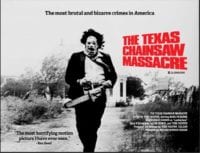Anthologies are notoriously difficult to get completely right, and that’s because in almost any form, be it books, movies, or even video games, you have multiple voices speaking at once, which can lead to severe whiplash. It’s why Trick R Treat is now a beloved Halloween classic; not only does every story absolutely deliver, but it has a sense of cohesiveness since only Michael Doughtery wrote and directed for it. It can be tough to decide what to watch when you’re presented with an anthology. It almost feels like taking some grand risk. Fear not, dear reader. The following are horror anthologies that I’ve found to be worth anyone’s time.
VHS 2
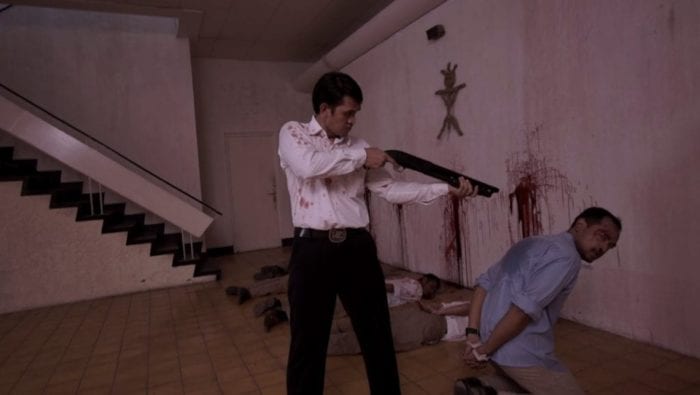
I would lump the first installment in this found footage franchise here as well because I think it’s an overall stronger collection than this sequel, but this movie contains what is arguably the best short horror film of the 2010s, which is why it’s on here. For those that don’t know, each VHS movie has a wraparound story where hapless characters stumble upon a collection of haunted, you guessed it, VHS tapes which contain disturbing footage. In each movie, the more tapes they watch, the worse that things become. In the case of this second entry, the wraparound concerns two thieves breaking into a home to find these tapes, and each story is a part of the collection they find.
The first one, “Phase 1 Clinical Trials,” is a decent enough effort from Adam Wingard, the director behind You’re Next and The Guest, which rank high among my favorite genre movies. This story follows a man who gets a cybernetic eye transplant that allows him to see ghosts. It’s a neat idea, and like most stories in the first two movies, works as a way of getting around the biggest found footage plot hole of all: why characters keep filming. The protagonist doesn’t even realize he’s filming since the camera is his new eyeball. This story is decent enough and contains some decent stuff but feels rather run of the mill considering the two stories that follow it.
The next up is “A Ride in the Park,” directed by Gregg Hale and Eduardo Sanchez. This is one of the most fun instances of the found footage format I’ve ever seen. It follows a random biker who is shooting a GoPro video while mountain biking in the woods when he’s attacked by zombies and turns into one himself. What follows is a gory as hell, first-person story told entirely from the zombie’s perspective, with the camera on his helmet showing the viewer an unflinching look at a day in the life of the undead. It all culminates in a kid’s birthday party in the park. It’s not mind-blowing, but it’s a truly novel and fresh take on both zombie movies and found footage movies.
The next short film, though, is why VHS 2 is among my favorite horror anthologies. “Safe Haven,” directed by Gareth Evans and Timo Tjajhanto, is a 40-ish minute exercise in almost nonstop, in your face, overwhelming tension. “Safe Haven” follows a group of documentary filmmakers as they interview the leader of a Jim Jones-esque cult and discover that something much more sinister is going on. A common pitfall of found footage movies is that they mistake boring scenes for exposition and random character banter with development. That’s not the case here. There’s interpersonal drama, with some questionable paternity of the pregnant female member and conflicting approaches to how the crew should go about gathering information. In other words, it takes the time to establish its characters.
Then, about halfway through, everything goes to hell. The once normal commune becomes a slaughterhouse, with all of the cultists committing suicide, air raid sirens going off, and the pregnant crew member experiencing rapidly developing symptoms. The first person view of every character means the viewer is placed right in the middle of the mayhem along with the characters, and nothing is held back during the frantic second half, which turns into an ultra-gory and anxiety-inducing experience with nightmarish imagery and disturbing violence that shocks the viewer senseless. I’m remaining vague about it because this is the kind of short film that works best when you have little to no idea of what’s going to happen. Unlike the majority of the genre, “Safe Haven” is made with real cinematic skill and is paced exceptionally well, which makes the carnage in its second half all the more shocking and visceral.
It shouldn’t come as a surprise considering the directors, though. Gareth Evans made both of The Raid films, and if you haven’t seen them and consider yourself an action fan, you’re doing yourself a disservice, because they belong in the action-movie hall of fame. The same goes for Timo Tjahjanto, who directed such films as Headshot and The Night Comes For Us, which, like The Raid, are among the best action movies made in recent years. All of these films employ kinetic, frantic camera work that places the viewer in the insanely well-choreographed fight scenes, and even though “Safe Haven” is a very different kind of movie, this was an early sign of their mastery over cinematography, sound design, and editing to deliver maximum impact.
It’s a shame that “Safe Haven” is the third story in VHS 2¸because its final entry, “Slumber Party Alien Abduction,” is a severe letdown after the high of the previous entry. The title pretty much says it all, and it ends on a whopper of an anti-climax, and it employs the worst elements of found footage—shaky cam, unlikable characters, an ending that renders the whole thing pointless. It’s far from the worst FF movie I’ve seen (pretty much everything in VHS Viral is either outright bad or unintentionally funny), but it should have been swapped with “Safe Haven” so the anthology could end on a real bang. Still, with one decent entry, a good entry, and a truly amazing entry, VHS 2 delivers more consistently frightening and inventive tales than the average anthology.
Tales of Halloween
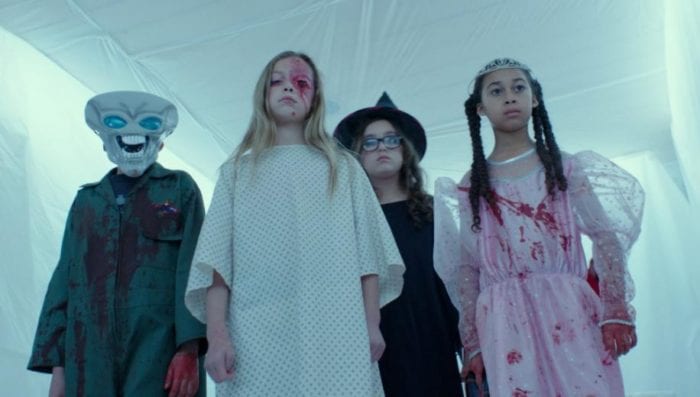
This is a movie that, like Trick R Treat, Boys In the Trees, and Shudder’s severely underappreciated seasonal slasher Haunt, could very easily become a tradition with any horror fan who yearns for a late-fall feeling at any time of the year. It’s infectious with the mood of All Hallow’s Eve. The short nature of each story means you could even turn it on for a few minutes at a time and still be put in a spooky mood. And for a movie with a stunning ten entries, all with different writers and directors, the consistency with which it delivers quality, fun tales is jaw-dropping.
The first real standout entry is the third, titled “Trick” and, directed by Adam Gierasch, sees a pair of thirty-something couples celebrating Halloween by having a few drinks and watching Night of the Living Dead (which acts as a timeline for all the different stories since it repeatedly pops up at different points). Then a young witch shows up at their door and stabs one of the men. What ensues is a brief, but utterly nasty home invasion with murderous trick or treaters and a twist that flips absolutely everything about the setup on its head. There’s some fantastic set design, with a heavily decorated house and eventually some other sets capturing a spooky, seasonal feeling well. It’s a brief but completely effective story that makes the most with its twist.
This one is immediately followed up with Paul Solet’s “The Weak and the Wicked,” which is a neat, Fall themed take on a Western. It sees a group of miscreants terrorizing an innocent trick or treater, kind of going full-on Stephen King bully by taking things way too far when a young man (It Follows alumni Kier Gilchrist) dressed as a horned demon intervenes. What follows is classic Western stuff, with a hidden past between the young man and the gang, and themes of redemption and revenge. It’s not as intense or scary as “Trick,” but it’s a hell of a lot of fun.
The story in here that completely goes for broke, and takes more than a little inspiration from the likes of Evil Dead 2, is Mike Mendez’s “Friday the 31st.” The story begins at the end of a traditional slasher movie, the final showdown between the Final Girl and a legally safe knockoff of Jason Voorhees. Without giving too much away, things don’t go her way, but then things don’t go the killer’s way, either. It employs an out of nowhere, mid-way twist that turns the entire story into a masterclass in practical effects and over-the-top horror-comedy. It starts at 60 and eventually revs on up to 120, and it’s a blast from start to finish.
The real key with Tales of Halloween is that there isn’t a single bad story in the bunch. As much as I love VHS 2, I have to admit that the final entry is a real let down. Tales of Halloween delivers fun across the board, whether it’s the tonally bizarre “The Night Billy Raised Hell,” the gory “Sweet Tooth,” or the darkly humorous entries “The Ransom of Rusty Rex” and “Bad Seed,” there’s plenty of variety on offer here. Even the two weakest entries, the neatly premised, but so-so executed “This Means War” (which follows a Halloween decoration contest between a conservative middle-aged man and a bunch of metalheads) and the atmospheric but seriously anticlimactic “Grim Grinning Ghost” (which stars a seriously underutilized Alex Essoe), have something to offer. It’s a spooky good time, and worth a look for anyone with a fondness for All Hallow’s Eve.
Southbound
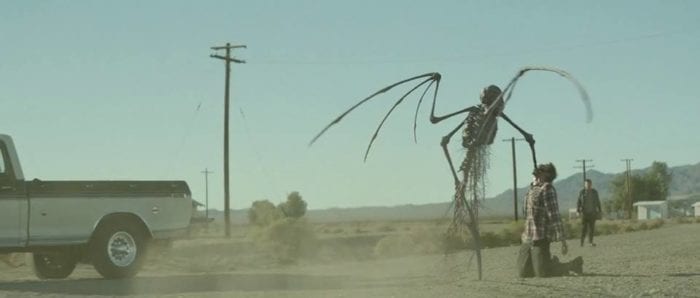
This was one I was skeptical about going into initially—I’ve been burned before on movies with lots of hype behind them. And granted, the amount of hype behind Southbound is relative to its indie roots, but still, the principle applies. Anyways, it kind of floored me the first time I saw it. Like others on this list, this movie features multiple directors and writers, but it has a sense of place and cohesiveness that rivals the best horror anthologies out there. In fact, I would argue the world and mood it creates is stronger than any individual story on offer.
Southbound has five tales, all of them connected in one way or another. Each one takes place in the same unnamed town which is not at all what it seems. This is clear from the get-go, with the opening story, “The Way Out” featuring two ill-fated criminals trapped on the same stretch of highway. They refuel and restock on food at a gas station/convenience store, and both of them are covered in blood. No one really seems to notice, and when they pull away they reappear at the same station over and over again. Eventually, they find they are haunted by bizarre, skeletal demon things that chase them down. It’s a weird, effective opening that sets the tone for the relatable-but-otherworldly tone the movie goes for.
The next story is “Siren,” which follows a small jazz band as they are picked up by a seemingly friendly middle-aged couple because their van has broken down. There’s some real tension here, with weird meat during dinner and odd behavior by the locals really getting under the viewer’s skin, before it all culminates in a super weird, oddly ambiguous finale that leads directly into “The Accident,” which is one of the most downright nasty short films ever put to screen. In it, a man driving along the lonely highway that functions as the movie’s setting runs into the lone survivor of “Siren,” with horrifically brutal results. It’s in this short film that the movie really becomes something otherworldly—the man in question is called by strange people who seem to know everything about him. They direct him to an abandoned hospital where they give him instructions on the surgery he has to perform in order to save the woman he ran over. It’s hopeless but also the only tale in this anthology that technically ends well for the antagonist.
Following that is “Jailbreak,” which sees a man coming to town in order to find his sister. It’s here that the townspeople are revealed to be more than just human. One man in the bar, where the story’s first act takes place, is seen to have claws for hands. And he has to enter the bar by taking a townsperson hostage, where they enter the door to the bar by looking at it through an eye tattoo on the back of their hand. It’s a lovely, small piece of world-building that gives the movie its sense of unique atmosphere. The rest of the story has a few surprises, as does the final one, “The Way In,” which gives some very, very dark context to the opening story and delivers a few final twists for the world that Southbound creates.
The thing that sets Southbound apart is how well it builds its setting in between its separate stories. With the end and beginning of each story, we move on from the current one to the new one, and there are little bits of lore dropped here and there to clue the viewer into what’s going on. Ultimately, the logical conclusion is that wherever this movie takes place, it’s some version of hell. Most of the tales here involve people receiving punishment for some sort of crime they’ve committed; for instance, in “Siren,” there is mention of one of the band members possibly being responsible for a missing member’s death by drunk driving. But it even goes beyond that—anyone who has driven very, very late at night can tell you that reality changes when you’re moving along familiar roads when no one else is.
Southbound captures that strange, almost surreal feeling of unreality that comes from driving through the night. If I’m driving late at night, I have a tendency to make up stories about the places I pass by, and those stories tend to be dark, odd, and creepy. Southbound gives concrete details to that kind of personal storytelling—the highway/ town is never given a name. In fact, the only time the viewer sees a highway sign, it’s totally blank. Despite the supernatural elements, or perhaps because of them, the loneliness and creepiness of Southbound feel almost relatable in a way, which makes the horror in every story all the more impactful.
Also, this movie has Larry Fessenden as a late-night radio DJ, and he steals the scene every time he shows up despite the fact that he doesn’t have a physical presence at all in the movie. That’s worth something.
Bonus Round: Slasher
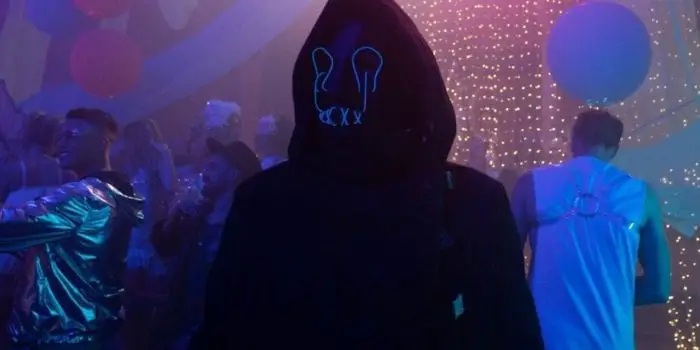
For those not in the know, Slasher is a Canadian TV series where each season is a new story in the, you guessed it, slasher genre. This is a show I have a love/hate relationship with, and that’s because it emulates both the best and worst elements of the slasher subgenre. In the first season, a killer dressed as a medieval executioner kills people who are guilty of one of the seven deadly sins. In the second, a killer stalks a group of people who return to an old camp where something very bad happened a long time ago. And the third season deals with a killer slaughtering folks in an apartment building where various bad things have happened.
I find myself conflicted about this series. It’s not, strictly speaking, good. But it’s eminently watchable in a very trashy way. Each season has wild plot twists with people sleeping with one another, betrayals, and friends who shouldn’t really be friends because of these sorts of things. It’s basically a soap opera, but it’s a soap opera with absolutely wild and downright nasty kills. The third season, subtitled Solstice, doubles down on all of this. The characters are all really not great people, they all sleep with each other, and not very many are likable, but it also has some of the most violent kills you’ll ever see on TV.
This show is absolutely a guilty pleasure of mine thanks to these elements. It’s tough to say the writing in it is good or even passable, but it delivers on the murder mystery element each season and has some top-notch gore effects.

